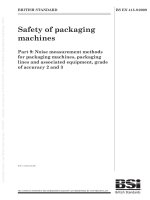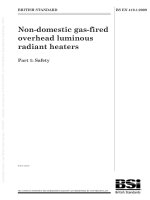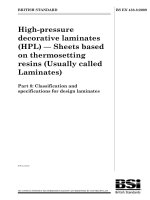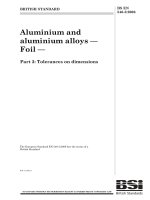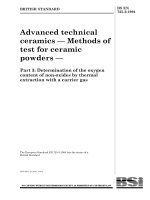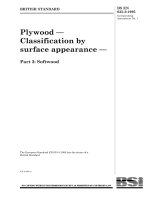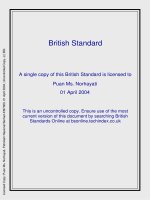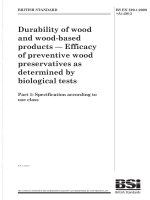Bsi bs en 61400 3 2009
Bạn đang xem bản rút gọn của tài liệu. Xem và tải ngay bản đầy đủ của tài liệu tại đây (2.26 MB, 132 trang )
BS EN 61400-3:2009
BSI British Standards
Wind turbines —
Part 3: Design requirements for offshore
wind turbines
NO COPYING WITHOUT BSI PERMISSION EXCEPT AS PERMITTED BY COPYRIGHT LAW
raising standards worldwide™
BRITISH STANDARD
BS EN 61400-3:2009
National foreword
This British Standard is the UK implementation of EN 61400-3:2009. It is
identical to IEC 61400-3:2009.
The UK participation in its preparation was entrusted by Technical Committee
PEL/88, Wind turbines, to Panel PEL/88/-/3, Designs of offshore turbines
(WG 3).
A list of organizations represented on this committee can be obtained on
request to its secretary.
This publication does not purport to include all the necessary provisions of a
contract. Users are responsible for its correct application.
© BSI 2009
ISBN 978 0 580 60156 9
ICS 27.180
Compliance with a British Standard cannot confer immunity from
legal obligations.
This British Standard was published under the authority of the Standards
Policy and Strategy Committee on 31 May 2009
Amendments issued since publication
Amd. No.
Date
Text affected
BS EN 61400-3:2009
EUROPEAN STANDARD
EN 61400-3
NORME EUROPÉENNE
EUROPÄISCHE NORM
April 2009
ICS 27.180
English version
Wind turbines Part 3: Design requirements
for offshore wind turbines
(IEC 61400-3:2009)
Eoliennes Partie 3: Exigences de conception
des éoliennes en pleine mer
(CEI 61400-3:2009)
Windenergieanlagen Teil 3: Auslegungsanforderungen
für Windenergieanlagen auf offener See
(IEC 61400-3:2009)
This European Standard was approved by CENELEC on 2009-04-01. CENELEC members are bound to comply
with the CEN/CENELEC Internal Regulations which stipulate the conditions for giving this European Standard
the status of a national standard without any alteration.
Up-to-date lists and bibliographical references concerning such national standards may be obtained on
application to the Central Secretariat or to any CENELEC member.
This European Standard exists in three official versions (English, French, German). A version in any other
language made by translation under the responsibility of a CENELEC member into its own language and notified
to the Central Secretariat has the same status as the official versions.
CENELEC members are the national electrotechnical committees of Austria, Belgium, Bulgaria, Cyprus, the
Czech Republic, Denmark, Estonia, Finland, France, Germany, Greece, Hungary, Iceland, Ireland, Italy, Latvia,
Lithuania, Luxembourg, Malta, the Netherlands, Norway, Poland, Portugal, Romania, Slovakia, Slovenia, Spain,
Sweden, Switzerland and the United Kingdom.
CENELEC
European Committee for Electrotechnical Standardization
Comité Européen de Normalisation Electrotechnique
Europäisches Komitee für Elektrotechnische Normung
Central Secretariat: avenue Marnix 17, B - 1000 Brussels
© 2009 CENELEC -
All rights of exploitation in any form and by any means reserved worldwide for CENELEC members.
Ref. No. EN 61400-3:2009 E
BS EN 61400-3:2009
EN 61400-3:2009
–2–
Foreword
The text of document 88/329/FDIS, future edition 1 of IEC 61400-3, prepared by IEC TC 88, Wind
turbines, was submitted to the IEC-CENELEC parallel vote and was approved by CENELEC as
EN 61400-3 on 2009-04-01.
This European Standard is to be read in conjunction with EN 61400-1:2005.
The following dates were fixed:
– latest date by which the EN has to be implemented
at national level by publication of an identical
national standard or by endorsement
(dop)
2010-01-01
– latest date by which the national standards conflicting
with the EN have to be withdrawn
(dow)
2012-04-01
Annex ZA has been added by CENELEC.
__________
Endorsement notice
The text of the International Standard IEC 61400-3:2009 was approved by CENELEC as a European
Standard without any modification.
In the official version, for Bibliography, the following notes have to be added for the standards indicated:
IEC 60034
NOTE Harmonized in EN 60034 series (partially modified).
IEC 60038
NOTE Harmonized as HD 472 S1:1989 (modified), with the following title “Nominal voltages for
low-voltage public electricity supply systems”.
IEC 60146
NOTE Harmonized in EN 60146 series (not modified).
IEC 60204-1
NOTE Harmonized as EN 60204-1:2006 (modified).
IEC 60204-11
NOTE Harmonized as EN 60204-11:2000 (not modified).
IEC 60227
NOTE Is related to HD 21 series (not equivalent).
IEC 60245
NOTE Is related to HD 22 series (not equivalent).
IEC 60269
NOTE Harmonized in EN 60269 series (modified).
IEC 60364
NOTE Harmonized in HD 384/HD 60364 series (modified).
IEC 60439
NOTE Harmonized in EN 60439 series (partially modified).
IEC 60446
NOTE Harmonized as EN 60446:1999 (not modified).
IEC 60529
NOTE Harmonized as EN 60529:1991 (not modified).
IEC 61000-6-1
NOTE Harmonized as EN 61000-6-1:2007 (not modified).
IEC 61000-6-2
NOTE Harmonized as EN 61000-6-2:2005 (not modified).
IEC 61000-6-4
NOTE Harmonized as EN 61000-6-4:2007 (not modified).
IEC 61310-1
NOTE Harmonized as EN 61310-1:1995 (not modified).
IEC 61310-2
NOTE Harmonized as EN 61310-2:1995 (not modified).
IEC 61400-21
NOTE Harmonized as EN 61400-21:2002 (not modified).
__________
BS EN 61400-3:2009
–3–
EN 61400-3:2009
Annex ZA
(normative)
Normative references to international publications
with their corresponding European publications
The following referenced documents are indispensable for the application of this document. For dated
references, only the edition cited applies. For undated references, the latest edition of the referenced
document (including any amendments) applies.
NOTE When an international publication has been modified by common modifications, indicated by (mod), the relevant EN/HD
applies.
Publication
Year
Title
EN/HD
Year
IEC 60721-2-1
+ A1
1982
1987
Classification of environmental conditions Part 2-1: Environmental conditions
appearing in nature - Temperature and
humidity
HD 478.2.1 S1
1989
IEC 61400-1
2005
Wind turbines Part 1: Design requirements
EN 61400-1
2005
IEC 62305-3
(mod)
2006
Protection against lightning Part 3: Physical damage to structures and
life hazard
EN 62305-3
+ corr. September
+ A11
2006
2008
2009
IEC 62305-4
2006
Protection against lightning Part 4: Electrical and electronic systems
within structures
EN 62305-4
+ corr. November
2006
2006
ISO 2394
1998
General principles on reliability for
structures
-
-
ISO 2533
1975
Standard atmosphere
-
-
ISO 9001
2000
Quality management systems Requirements
EN ISO 9001
2000
ISO 19900
2002
Petroleum and natural gas industries EN ISO 19900
General requirements for offshore structures
2002
ISO 19901-1
2005
Petroleum and natural gas industries Specific requirements for offshore
structures Part 1: Metocean design and operating
considerations
EN ISO 19901-1
2005
ISO 19901-4
2003
Petroleum and natural gas industries Specific requirements for offshore
structures Part 4: Geotechnical and foundation design
considerations
EN ISO 19901-4
2003
ISO 19902
-
ISO 19903
2006
1)
2)
1)
Undated reference.
Valid edition at date of issue.
www.bzfxw.com
Petroleum and natural gas industries - Fixed EN ISO 19902
steel offshore structures
2007
Petroleum and natural gas industries - Fixed EN ISO 19903
concrete offshore structures
2006
2)
BS EN 61400-3:2009
–4–
61400-3 © IEC:2009
CONTENTS
INTRODUCTION .....................................................................................................................7
1
Scope ...............................................................................................................................8
2
Normative references........................................................................................................8
3
Terms and definitions .......................................................................................................9
4
Symbols and abbreviated terms ...................................................................................... 15
5
4.1 Symbols and units ................................................................................................. 15
4.2 Abbreviations......................................................................................................... 16
Principal elements .......................................................................................................... 17
6
5.1 General ................................................................................................................. 17
5.2 Design methods..................................................................................................... 17
5.3 Safety classes ....................................................................................................... 19
5.4 Quality assurance .................................................................................................. 19
5.5 Rotor – nacelle assembly markings ........................................................................ 20
External conditions ......................................................................................................... 20
7
6.1 General ................................................................................................................. 20
6.2 Wind turbine classes ............................................................................................. 21
6.3 Wind conditions ..................................................................................................... 21
6.4 Marine conditions .................................................................................................. 22
6.5 Other environmental conditions .............................................................................. 31
6.6 Electrical power network conditions........................................................................ 32
Structural design............................................................................................................. 33
8
7.1 General ................................................................................................................. 33
7.2 Design methodology .............................................................................................. 33
7.3 Loads .................................................................................................................... 33
7.4 Design situations and load cases ........................................................................... 34
7.5 Load and load effect calculations ........................................................................... 51
7.6 Ultimate limit state analysis.................................................................................... 54
Control and protection system ......................................................................................... 57
9
Mechanical systems........................................................................................................ 57
www.bzfxw.com
10 Electrical system............................................................................................................. 58
11 Foundation design .......................................................................................................... 58
12 Assessment of the external conditions at an offshore wind turbine site ............................ 59
12.1
12.2
12.3
12.4
12.5
12.6
12.7
12.8
12.9
12.10
12.11
General .............................................................................................................. 59
The metocean database...................................................................................... 59
Assessment of wind conditions............................................................................ 60
Assessment of waves ......................................................................................... 62
Assessment of currents....................................................................................... 63
Assessment of water level, tides and storm surges.............................................. 63
Assessment of sea ice ........................................................................................ 63
Assessment of marine growth ............................................................................. 64
Assessment of seabed movement and scour ....................................................... 64
Assessment of wake effects from neighbouring wind turbines .............................. 65
Assessment of other environmental conditions .................................................... 65
BS EN 61400-3:2009
61400-3 © IEC:2009
−5−
12.12 Assessment of earthquake conditions ................................................................. 65
12.13 Assessment of weather windows and weather downtime...................................... 65
12.14 Assessment of electrical network conditions ........................................................ 65
12.15 Assessment of soil conditions ............................................................................. 66
13 Assembly, installation and erection ................................................................................. 67
13.1
General .............................................................................................................. 67
13.2
Planning ............................................................................................................. 68
13.3
Installation conditions.......................................................................................... 68
13.4
Site access ......................................................................................................... 68
13.5
Environmental conditions .................................................................................... 68
13.6
Documentation.................................................................................................... 69
13.7
Receiving, handling and storage.......................................................................... 69
13.8
Foundation/anchor systems................................................................................. 69
13.9
Assembly of offshore wind turbine ....................................................................... 69
13.10 Erection of offshore wind turbine ......................................................................... 69
13.11 Fasteners and attachments ................................................................................. 69
13.12 Cranes, hoists and lifting equipment.................................................................... 70
14 Commissioning, operation and maintenance ................................................................... 70
14.1
14.2
14.3
14.4
14.5
Annex A
General ................................................................................................................. 70
Design requirements for safe operation, inspection and maintenance ..................... 70
Instructions concerning commissioning .................................................................. 71
Operator’s instruction manual ................................................................................ 72
Maintenance manual.............................................................................................. 74
(informative) Key design parameters for an offshore wind turbine............................ 76
www.bzfxw.com
Annex B (informative) Wave spectrum formulations .............................................................. 79
Annex C (informative) Shallow water hydrodynamics and breaking waves ............................. 84
Annex D (informative) Guidance on calculation of hydrodynamic loads.................................. 92
Annex E (informative) Recommendations for design of offshore wind turbine support
structures with respect to ice loads...................................................................................... 105
Annex F (informative) Offshore wind turbine foundation design ........................................... 116
Annex G (informative) Statistical extrapolation of operational metocean parameters for
ultimate strength analysis .................................................................................................... 117
Annex H (informative) Corrosion protection ........................................................................ 123
Bibliography ........................................................................................................................ 127
Figure 1 – Parts of an offshore wind turbine........................................................................... 10
Figure 2 – Design process for an offshore wind turbine.......................................................... 19
Figure 3 – Definition of water levels ....................................................................................... 29
Figure 4 – The two approaches to calculate the design load effect ......................................... 55
Figure B.1 – PM spectrum ..................................................................................................... 80
Figure B.2 – Jonswap and PM spectrums for typical North Sea storm sea state ..................... 81
Figure C.1 – Regular wave theory selection diagram.............................................................. 84
Figure D.1 – Breaking wave and cylinder parameters............................................................. 96
Figure D.2 – Oblique inflow parameters ................................................................................. 96
Figure D.3 – Distribution over height of the maximum impact line force ( γ = 0°) ...................... 98
BS EN 61400-3:2009
–6–
61400-3 © IEC:2009
Figure D.4 – Response of model and full-scale cylinder in-line and cross-flow (from
reference document 4) ........................................................................................................ 100
Figure E.1 – Ice force coefficients for plastic limit analysis (from reference document 6) ...... 110
Figure E.2 – Serrated load profile (T 0,1 = 1/f N or 1/f b ) .......................................................... 113
Figure G.1 – Example of the construction of the 50-year environmental contour for a 3-hour
sea state duration. .............................................................................................................. 118
Table 1 – Design load cases ................................................................................................. 36
Table 2 – Design load cases for sea ice ................................................................................ 50
Table 3 – Partial safety factors for loads γ f ............................................................................ 56
Table 4 – Conversion between extreme wind speeds of different averaging periods ............... 61
Table C.1 – Constants h 1 and h 2 and normalised wave heights h x% as a function of H tr .......... 87
Table C.2 – Breaking wave type ............................................................................................ 90
www.bzfxw.com
BS EN 61400-3:2009
61400-3 © IEC:2009
−7−
INTRODUCTION
This part of IEC 61400 outlines minimum design requirements for offshore wind turbines and is
not intended for use as a complete design specification or instruction manual.
Several different parties may be responsible for undertaking the various elements of the
design, manufacture, assembly, installation, erection, commissioning, operation and
maintenance of an offshore wind turbine and for ensuring that the requirements of this
standard are met. The division of responsibility between these parties is a contractual matter
and is outside the scope of this standard.
Any of the requirements of this standard may be altered if it can be suitably demonstrated that
the safety of the system is not compromised. Compliance with this standard does not relieve
any person, organization, or corporation from the responsibility of observing other applicable
regulations.
www.bzfxw.com
BS EN 61400-3:2009
–8–
61400-3 © IEC:2009
WIND TURBINES –
Part 3: Design requirements for offshore wind turbines
1
Scope
This part of IEC 61400 specifies additional requirements for assessment of the external
conditions at an offshore wind turbine site and it specifies essential design requirements to
ensure the engineering integrity of offshore wind turbines. Its purpose is to provide an
appropriate level of protection against damage from all hazards during the planned lifetime.
This standard focuses on the engineering integrity of the structural components of an offshore
wind turbine but is also concerned with subsystems such as control and protection
mechanisms, internal electrical systems and mechanical systems.
A wind turbine shall be considered as an offshore wind turbine if the support structure is
subject to hydrodynamic loading. The design requirements specified in this standard are not
necessarily sufficient to ensure the engineering integrity of floating offshore wind turbines.
This standard should be used together with the appropriate IEC and ISO standards mentioned
in Clause 2. In particular, this standard is fully consistent with the requirements of IEC 614001. The safety level of the offshore wind turbine designed according to this standard shall be at
or exceed the level inherent in IEC 61400-1. In some clauses, where a comprehensive
statement of requirements aids clarity, replication of text from IEC 61400-1 is included.
www.bzfxw.com
2
Normative references
The following referenced documents are indispensable for the application of this document. For
dated references, only the edition cited applies. For undated references, the latest edition of
the referenced document (including any amendments) applies.
IEC 60721-2-1:1982, Classification of environmental conditions – Part 2-1: Environmental
conditions appearing in nature. Temperature and humidity
Amendment 1:1987
IEC 61400-1:2005, Wind turbines – Part 1: Design requirements
IEC 62305-3:2006, Protection against lightning – Part 3: Physical damage to structures and life
hazard
IEC 62305-4:2006, Protection against lightning – Part 4: Electrical and electronic systems
within structures
ISO 2394:1998, General principles on reliability for structures
ISO 2533:1975, Standard Atmosphere
ISO 9001:2000, Quality management systems – Requirements
ISO 19900:2002, Petroleum and natural gas industries – General requirements for offshore
structures
BS EN 61400-3:2009
61400-3 © IEC:2009
−9−
ISO 19901-1:2005, Petroleum and natural gas industries – Specific requirements for offshore
structures – Part 1: Metocean design and operating conditions
ISO 19901-4:2003, Petroleum and natural gas industries – Specific requirements for offshore
structures – Part 4: Geotechnical and foundation design considerations
ISO 19902, Petroleum and natural gas industries – Fixed steel offshore structures
ISO 19903: 2006, Petroleum and natural gas industries – Fixed concrete offshore structures
3
Terms and definitions
For the purposes of this document, the following terms and definitions apply in addition to
those stated in IEC 61400-1.
3.1
co-directional (wind and waves)
acting in the same direction
3.2
current
flow of water past a fixed location usually described in terms of a current speed and direction
3.3
design wave
deterministic wave with a defined height, period and direction, used for the design of an
offshore structure. A design wave may be accompanied by a requirement for the use of a
particular periodic wave theory
www.bzfxw.com
3.4
designer
party or parties responsible for the design of an offshore wind turbine
3.5
environmental conditions
characteristics of the environment (wind, waves, sea currents, water level, sea ice, marine
growth, scour and overall seabed movement, etc.) which may affect the wind turbine behaviour
3.6
external conditions (wind turbines)
factors affecting operation of an offshore wind turbine, including the environmental conditions,
the electrical network conditions, and other climatic factors (temperature, snow, ice, etc.)
3.7
extreme significant wave height
expected value of the highest significant wave height, averaged over 3 h, with an annual
probability of exceedance of 1/N (“recurrence period”: N years)
3.8
extreme wave height
expected value of the highest individual wave height (generally the zero up-crossing wave
height) with an annual probability of exceedance of 1/N (“recurrence period”: N years)
BS EN 61400-3:2009
61400-3 © IEC:2009
– 10 –
3.9
fast ice cover
rigid continuous cover of ice not in motion
3.10
fetch
distance over which the wind blows constantly over the sea with approximately constant wind
speed and direction
3.11
foundation
part of an offshore wind turbine support structure which transfers the loads acting on the
structure into the seabed. Different foundation concepts are shown in Figure 1 together with
the other parts of an offshore wind turbine
Rotor-nacelle assembly
Tower
www.bzfxw.com
Tower
Support
structure
Platform
Water level
Sub-structure
Sub-structure
Pile
Sea floor
Pile
Seabed
Foundation
IEC 001/09
Figure 1 – Parts of an offshore wind turbine
3.12
highest astronomical tide
highest still water level that can be expected to occur under any combination of astronomical
conditions and under average meteorological conditions. Storm surges, which are
meteorologically generated and essentially irregular, are superimposed on the tidal variations,
so that a total still water level above highest astronomical tide may occur
BS EN 61400-3:2009
61400-3 © IEC:2009
− 11 −
3.13
hindcasting
method of simulating historical (metocean) data for a region through numerical modelling
3.14
hub height (wind turbines)
height of the centre of the swept area of the wind turbine rotor above the mean sea level
3.15
hummocked ice
crushed ice and ice floes piled up into ridges when large ice floes meet with each other or with
a rigid obstacle, for example an offshore wind turbine support structure
3.16
ice floe
sheet of ice in size from metres to several kilometres, not rigidly frozen to a shore, still or in
motion
3.17
icing
build-up of a cover of ice or frost on parts of an offshore wind turbine that can result in added
loads and/or changed properties
3.18
land-locked waters
waters almost or entirely surrounded by land
www.bzfxw.com
3.19
load effect
effect of a single load or combination of loads on a structural component or system, for
example internal force, stress, strain, motion, etc.
3.20
lowest astronomical tide
lowest still water level that can be expected to occur under any combination of astronomical
conditions and under average meteorological conditions. Storm surges, which are
meteorologically generated and essentially irregular, are superimposed on the tidal variations,
so that a total still water level below lowest astronomical tide may occur
3.21
manufacturer
party or parties responsible for the manufacture and construction of an offshore wind turbine
3.22
marine conditions
characteristics of the marine environment (waves, sea currents, water level, sea ice, marine
growth, seabed movement and scour, etc.) which may affect the wind turbine behaviour
3.23
marine growth
surface coating on structural components caused by plants, animals and bacteria
3.24
mean sea level
average level of the sea over a period of time long enough to remove variations due to waves,
tides and storm surges
BS EN 61400-3:2009
– 12 –
61400-3 © IEC:2009
3.25
mean zero crossing period
average period of the zero-crossing (up or down) waves in a sea state
3.26
metocean
abbreviation of meteorological and oceanographic
3.27
multi-directional (wind and/or wave)
distribution of directions
3.28
offshore wind turbine
wind turbine with a support structure which is subject to hydrodynamic loading
3.29
offshore wind turbine site
the location or intended location of an individual offshore wind turbine either alone or within a
wind farm
3.30
pile penetration
vertical distance from the sea floor to the bottom of the pile
www.bzfxw.com
3.31
power collection system (wind turbines)
electric system that collects the power from one or more wind turbines. It includes all electrical
equipment connected between the wind turbine terminals and the network connection point.
For offshore wind farms, the power collection system may include the connection to shore
3.32
reference period
period during which stationarity is assumed for a given stochastic process, for example wind
speed, sea elevation or response
3.33
refraction
process by which wave energy is redistributed as a result of changes in the wave propagation
velocity due to variations in water depth and/or current velocity
3.34
residual currents
components of a current other than tidal current. The most important is often the storm surge
current
3.35
rotor – nacelle assembly
part of an offshore wind turbine carried by the support structure, refer to Figure 1
3.36
sea floor
interface between the sea and the seabed
BS EN 61400-3:2009
61400-3 © IEC:2009
− 13 −
3.37
sea floor slope
local gradient of the sea floor, for example associated with a beach
3.38
sea state
condition of the sea in which its statistics remain stationary
3.39
seabed
materials below the sea floor in which a support structure is founded
3.40
seabed movement
movement of the seabed due to natural geological processes
3.41
scour
removal of seabed soils by currents and waves or caused by structural elements interrupting
the natural flow regime above the sea floor
3.42
significant wave height
statistical measure of the height of waves in a sea state, defined as 4 × σ η where σ η is the
standard deviation of the sea surface elevation. In sea states with only a narrow band of wave
frequencies, the significant wave height is approximately equal to the mean height of the
highest third of the zero up-crossing waves
www.bzfxw.com
3.43
splash zone
external region of support structure that is frequently wetted due to waves and tidal variations.
This shall be defined as the zone between
–
the highest still water level with a recurrence period of 1 year increased by the crest height
of a wave with height equal to the significant wave height with a return period of 1 year, and
–
the lowest still water level with a recurrence period of 1 year reduced by the trough depth of
a wave with height equal to the significant wave height with a return period of 1 year
3.44
still water level
abstract water level calculated by including the effects of tides and storm surge but excluding
variations due to waves. Still water level can be above, at, or below mean sea level
3.45
storm surge
irregular movement of the sea brought about by wind and atmospheric pressure variations
3.46
sub-structure
part of an offshore wind turbine support structure which extends upwards from the seabed and
connects the foundation to the tower, refer to Figure 1
3.47
support structure
part of an offshore wind turbine consisting of the tower, sub-structure and foundation, refer to
Figure 1
BS EN 61400-3:2009
– 14 –
61400-3 © IEC:2009
3.48
swell
sea state in which waves generated by winds remote from the site have travelled to the site,
rather than being locally generated
3.49
tidal current
current resulting from tides
3.50
tidal range
distance between the highest astronomical tide and the lowest astronomical tide
3.51
tides
regular and predictable movements of the sea generated by astronomical forces
3.52
tower
part of an offshore wind turbine support structure which connects the sub-structure to the rotor
– nacelle assembly, refer to Figure 1
3.53
tsunami
long period sea waves caused by rapid vertical movements of the sea floor
3.54
uni-directional (wind and/or waves)
acting in a single direction
www.bzfxw.com
3.55
water depth
vertical distance between the sea floor and the still water level
NOTE
As there are several options for the still water level (see 3.44) there can be several water depth values.
3.56
wave crest elevation
vertical distance between the crest of a wave and the still water level
3.57
wave direction
mean direction from which the wave is travelling
3.58
wave height
vertical distance between the highest and lowest points on the water surface of an individual
zero up-crossing wave
3.59
wave period
time interval between the two zero up-crossings which bound a zero up-crossing wave
3.60
wave spectral peak frequency
frequency of the peak energy in the wave spectrum
BS EN 61400-3:2009
61400-3 © IEC:2009
− 15 −
3.61
wave spectrum
frequency domain description of the sea surface elevation in a sea state
3.62
wave steepness
ratio of the wave height to the wave length
3.63
weather downtime
one or more intervals of time during which the environmental conditions are too severe to allow
for execution of a specified marine operation
3.64
weather window
interval of time during which the environmental conditions allow for execution of a specified
marine operation
3.65
wind profile – wind shear law
mathematical expression for assumed wind speed variation with height above still water level
NOTE
Commonly used profiles are the logarithmic profile (equation 1) and the power law profile (equation 2).
V ( z ) = V ( zr ) ⋅
In(z z0 )
In(zr z0 )
(1)
www.bzfxw.com
α
⎛ z ⎞
V ( z ) = V (zr ) ⋅ ⎜⎜ ⎟⎟
⎝ zr ⎠
(2)
where
V ( z ) is the wind speed at height z ;
z
is the height above the still water level;
zr
is a reference height above the still water level used for fitting the profile;
z 0 is the roughness length;
α
is the wind shear (or power law) exponent.
3.66
zero up-crossing wave
portion of a time history of wave elevation between zero up-crossings. A zero up-crossing
occurs when the sea surface rises (rather than falls) through the still water level
4
Symbols and abbreviated terms
For the purposes of this document, the following symbols and abbreviated terms apply in
addition to those stated in IEC 61400-1:
4.1
Symbols and units
AC
Charnock’s constant
d
water depth
fp
wave spectral peak frequency
g
acceleration due to gravity
[-]
[m]
[s –1 ]
[m/s 2 ]
BS EN 61400-3:2009
– 16 –
61400-3 © IEC:2009
h
thickness of sea ice
[m]
hN
thickness of sea ice with a recurrence period of N years
[m]
hm
ice thickness equal to the long term mean value of the annual
maximum ice thickness for winters with ice
[m]
H
individual wave height
[m]
HB
breaking wave height
[m]
HD
design wave height
[m]
HN
individual wave height with a recurrence period of N years
[m]
Hs
significant wave height
[m]
H sN
significant wave height with a recurrence period of N years
[m]
H redN
reduced wave height with a recurrence period of N years
[m]
k
wave number
Kmax
accumulated freezing degree-days
s
sea floor slope
[-]
[°C]
[°]
p ( V hub ) probability density function of hub height wind speed
[-]
[m 2 /Hz]
Sη
single sided wave spectrum
Rd
design value for component resistance
[-]
Rk
characteristic value for component resistance
[-]
Sd
design value for load effect
[-]
Sk
characteristic value for load effect
t
time
T
wave period
[s]
TD
design wave period
[s]
Tp
peak spectral period
[s]
Tz
mean zero-crossing wave period
[s]
U ss
sub surface current velocity
[m/s]
Uw
wind generated current velocity
[m/s]
U bw
breaking wave induced surf current velocity
[m/s]
VN
expected extreme wind speed (averaged over 10 min), with a
recurrence period of N years
[m/s]
V redN
reduced extreme wind speed (averaged over three seconds), with a
recurrence period of N years
[m/s]
η
sea surface elevation relative to SWL
κ
von Karman’s constant
λ
wave length
θw
wave direction
[°]
θwm
mean wave direction
[°]
θc
current direction
[°]
ση
sea surface elevation standard deviation
τ
temperature
4.2
COD
www.bzfxw.com
[-]
[s]
Abbreviations
co-directional
[m]
[-]
[m]
[m]
[°C]
BS EN 61400-3:2009
61400-3 © IEC:2009
− 17 −
CPT
cone penetration test
DLC
design load case
ECD
extreme coherent gust with direction change
ECM
extreme current model
EDC
extreme direction change
EOG
extreme operating gust
ESS
extreme sea state
EWH
extreme wave height
EWLR
extreme water level range
EWM
extreme wind speed model
EWS
extreme wind shear
HAT
highest astronomical tide
LAT
lowest astronomical tide
MIC
microbiologically influenced corrosion
MIS
misaligned
MSL
mean sea level
MUL
multi-directional
NCM
normal current model
NSS
normal sea state
NTM
normal turbulence model
NWH
normal wave height
NWLR
normal water level range
NWP
normal wind profile model
RNA
rotor – nacelle assembly
RWH
reduced wave height
RWM
reduced wind speed model
SSS
severe sea state
SWH
severe wave height
SWL
still water level
UNI
uni-directional
5
5.1
www.bzfxw.com
Principal elements
General
The engineering and technical requirements to ensure the safety of the structural, mechanical,
electrical and control systems of an offshore wind turbine are given in the following clauses.
This specification of requirements applies to the design, manufacture, installation and manuals
for operation and maintenance of an offshore wind turbine and the associated quality
management process. In addition, safety procedures, which have been established in the
various practices that are used in the installation, operation and maintenance of an offshore
wind turbine, are taken into account.
5.2
Design methods
This standard requires the use of a structural dynamics model to predict design load effects.
Such a model shall be used to determine the load effects for all relevant combinations of
BS EN 61400-3:2009
– 18 –
61400-3 © IEC:2009
external conditions and design situations as defined in Clause 6 and Clause 7 respectively. A
minimum set of such combinations has been defined as load cases in this standard.
The design of the support structure of an offshore wind turbine shall be based on site-specific
external conditions. These shall therefore be determined in accordance with the requirements
stated in Clause 12. The conditions shall be summarized in the design basis.
In the case of the rotor – nacelle assembly, which may have been designed initially on the
basis of a standard wind turbine class as defined in IEC 61400-1, 6.2, it shall be demonstrated
that the offshore site-specific external conditions do not compromise the structural integrity.
The demonstration shall comprise a comparison of loads and deflections calculated for the
specific offshore wind turbine site conditions with those calculated during initial design, taking
account of the reserve margins and the influence of the environment on structural resistance
and the appropriate material selection. The calculation of loads and deflections shall also take
account of the influence of site-specific soil properties on the dynamic properties of an offshore
wind turbine, as well as potential long term time variation of these dynamic properties due to
seabed movement and scour.
The design process for an offshore wind turbine is illustrated in Figure 2. The figure indicates
the key elements of the design process and identifies the corresponding relevant clauses of
this standard. The process is iterative and shall incorporate load and load effect calculations
for the complete wind turbine comprising the integrated support structure and rotor – nacelle
assembly. The structural design of an offshore wind turbine may be regarded as completed
when its structural integrity has been verified based on the limit state analyses defined in 7.6.
Data from full scale testing may be used to increase confidence in predicted design values and
to verify structural dynamics models and design situations. Guidance relating to the
measurement of mechanical loads for full scale testing is available in IEC 61400-13.
www.bzfxw.com
Verification of the adequacy of the design shall be made by calculation and/or by testing. If test
results are used in this verification, the external conditions during the test shall be shown to
reflect the characteristic values and design situations defined in this standard. The selection of
test conditions, including the test loads, shall take account of the relevant safety factors.
BS EN 61400-3:2009
61400-3 © IEC:2009
− 19 −
Design initiated
Site-specific external
conditions (6, 12)
RNA design
(e.g. IEC 61400-1, standard
wind turbine class)
Design basis for offshore
wind turbine
Support structure design
RNA design
Design situations and load
cases (7.4)
Load and load effect
calculations (7.5)
Limit state analyses (7.6)
www.bzfxw.com
Structural integrity OK?
Design completed
IEC 002/09
Figure 2 – Design process for an offshore wind turbine
5.3
Safety classes
An offshore wind turbine shall be designed according to one of the following two safety classes:
•
a normal safety class that applies when a failure results in risk of personal injury or other
social or economic consequence;
•
a special safety class that applies when the safety requirements are determined by local
regulations and/or the safety requirements are agreed between the manufacturer and the
customer.
Partial safety factors for normal safety class wind turbines are specified in 7.6 of this standard.
Partial safety factors for special safety class wind turbines shall be agreed between the
manufacturer and the customer. An offshore wind turbine designed according to the special
safety class is a class S turbine as defined in 6.2.
5.4
Quality assurance
Quality assurance shall be an integral part of the design, procurement, manufacture,
installation, operation and maintenance of offshore wind turbines and all their components.
It is recommended that the quality system complies with the requirements of ISO 9001.
BS EN 61400-3:2009
– 20 –
5.5
61400-3 © IEC:2009
Rotor – nacelle assembly markings
The following information, as a minimum, shall be prominently and legibly displayed on the
indelibly marked rotor – nacelle assembly nameplate:
•
manufacturer and country;
•
model and serial number;
•
production year;
•
rated power;
•
•
reference wind speed, V ref ;
hub height operating wind speed range, V in – V out ;
operating ambient temperature range;
•
IEC wind turbine class (see IEC 61400-1);
•
rated voltage at the wind turbine terminals;
•
frequency at the wind turbine terminals or frequency range in the case that the nominal
variation is greater than 2 %.
6
External conditions
•
6.1
General
The external conditions described in this clause shall be considered in the design of an
offshore wind turbine.
www.bzfxw.com
Offshore wind turbines are subjected to environmental and electrical conditions that may affect
their loading, durability and operation. To ensure the appropriate level of safety and reliability,
environmental, electrical and soil parameters shall be taken into account in the design and
shall be explicitly stated in the design documentation.
The environmental conditions are divided into wind conditions, marine conditions (waves, sea
currents, water level, sea ice, marine growth, seabed movement and scour) and other
environmental conditions. The electrical conditions refer to the network conditions.
Account shall be taken of the soil properties at the site, including their time variation due to
seabed movement, scour and other elements of seabed instability.
Wind conditions are the primary external consideration for the structural integrity of the rotor –
nacelle assembly, although the marine conditions may also have an influence in some cases
depending on the dynamic properties of the support structure. In all cases, including the case
that the influence of marine conditions is shown to be of negligible importance during the
design of the rotor – nacelle assembly, the structural integrity shall be demonstrated taking
proper account of the marine conditions at each specific site at which the offshore wind turbine
will be subsequently installed.
Other environmental conditions also affect design features such as control system function,
durability, corrosion, etc.
The external conditions are subdivided into normal and extreme categories. The normal
external conditions generally concern recurrent structural loading conditions, while the extreme
external conditions represent rare external design conditions. The design load cases shall
consist of potentially critical combinations of these external conditions with wind turbine
operational modes and other design situations.
BS EN 61400-3:2009
61400-3 © IEC:2009
− 21 −
The normal and extreme conditions to be considered in design are prescribed in the following
subclauses.
6.2
Wind turbine classes
The external conditions to be considered in design are dependent on the intended site or site
type for an offshore wind turbine installation. In IEC 61400-1 wind turbine classes are defined
in terms of wind speed and turbulence parameters. The intention of the classes is to cover
most onshore applications.
For an offshore wind turbine the definition of wind turbine classes in terms of wind speed and
turbulence parameters remains appropriate as the basis of design of the rotor – nacelle
assembly.
A further wind turbine class, class S, is defined for use when special wind or other external
conditions or a special safety class, (see 5.3), is required by the designer and/or the customer.
In addition to wind speed and turbulence intensity, which define the wind turbine classes,
several other important parameters, notably marine conditions, are required to specify
completely the external conditions to be used in the design of an offshore wind turbine. The
values of these additional parameters are specified in 6.3, 6.4, 6.5 and 6.6.
The design lifetime shall be at least 20 years.
The manufacturer shall in the design documentation describe the models used and values of
essential design parameters. Where the models in Clause 6 are adopted, a statement of the
values of the parameters will be sufficient. The design documentation should contain the
information listed for guidance in Annex A.
www.bzfxw.com
The abbreviations added in parentheses in the subclause headings in the remainder of this
clause are used for describing the wind conditions for the design load cases defined in 7.4.
6.3
Wind conditions
An offshore wind turbine shall be designed to safely withstand the wind conditions adopted as
the basis of design.
The wind regime for load and safety considerations is divided into the normal wind conditions
which will occur more frequently than once per year during normal operation of an offshore
wind turbine, and the extreme wind conditions which are defined as having a 1-year or 50-year
recurrence period.
The design of the support structure of an offshore wind turbine shall be based on wind
conditions which are representative of the offshore wind turbine site and which shall be
assessed in accordance with the requirements stated in Clause 12.
For the rotor – nacelle assembly, the wind conditions assumed for design may be site-specific
or as defined by the models and parameter values specified in IEC 61400-1, although in this
latter case, it shall be demonstrated subsequently that site-specific external conditions do not
compromise the structural integrity. In the case that the wind conditions specified in IEC 614001 are used as the basis of design of the rotor – nacelle assembly, the following exceptions to
the models and parameter values may be assumed:
•
the inclination of the mean flow with respect to a horizontal plane is zero;
•
the wind profile, V ( z ), denotes the average wind speed as a function of height, z , above the
still water level. In the case of standard wind turbine classes, the normal wind speed profile
is given by the power law:
BS EN 61400-3:2009
– 22 –
V ( z ) = Vhub (z z hub )α
61400-3 © IEC:2009
(3)
where, for normal wind conditions, the power law exponent, α, is 0,14.
The occurrences of the extreme wind speed averaged over three seconds ( V e50 , V e1 ) and the
extreme wave height ( H 50 , H 1 ) are assumed to be uncorrelated and their combination is
conservative. The following reduced extreme wind speeds (RWM) shall therefore be used in
combination with the extreme wave heights:
Vred50 (z ) = 1,1Vref (z zhub )0,11
(4)
Vred1(z ) = 0,8 Vred50 (z )
(5)
and
6.4
Marine conditions
An offshore wind turbine shall be designed to withstand safely the marine conditions adopted
as the basis of design. The marine conditions described in this clause include waves, sea
currents, water level, sea ice, marine growth, scour and seabed movement. Other external
conditions relevant to the offshore environment are defined in 6.5.
The design of the support structure of an offshore wind turbine shall be based on
environmental conditions, including the marine conditions, which are representative of the
offshore wind turbine site.
www.bzfxw.com
The designer shall consider the influence of marine conditions on the rotor – nacelle assembly.
In most cases, the rotor – nacelle assembly of an offshore wind turbine will be designed not for
a specific site but rather to be suitable for a wide range of marine environments. The designer
may therefore assume generic marine conditions which reflect an environment at least as
severe as is anticipated for the use of the wind turbine. Depending on the dynamic properties
of the support structure and the assumed design marine conditions, the designer may in some
cases demonstrate by means of an appropriate analysis that the marine environment has a
negligible influence on the structural integrity of the rotor – nacelle assembly.
The marine conditions for load and safety considerations are divided into the normal marine
conditions which will occur more frequently than once per year during normal operation of an
offshore wind turbine, and the extreme marine conditions which are defined as having a 1-year
or 50-year recurrence period 1.
6.4.1
Waves
Waves are irregular in shape, vary in height, length and speed of propagation, and may
approach an offshore wind turbine from one or more directions simultaneously. The features of
a real sea are best reflected by describing a sea state by means of a stochastic wave model.
The stochastic wave model represents the sea state as the superposition of many small
individual frequency components, each of which is a periodic wave with its own amplitude,
frequency and direction of propagation; the components have random phase relationships to
each other. A design sea state shall be described by a wave spectrum, S η , together with the
significant wave height, H s , a peak spectral period, T p , and a mean wave direction, θ wm . Where
appropriate, the wave spectrum may be supplemented with a directional spreading function.
Standard wave spectrum formulations are provided in Annex B.
___________
1
The normal range of water levels is, however, defined in this standard as the variation in water level with a
recurrence period of 1 year, refer to 6.4.3.1.
BS EN 61400-3:2009
61400-3 © IEC:2009
− 23 −
In some applications, periodic or regular waves can be used as an abstraction of a real sea for
design purposes. A deterministic design wave shall be specified by its height, period and
direction.
The correlation of wind conditions and waves shall be taken into account for the design of an
offshore wind turbine. This correlation shall be considered in terms of the long term joint
probability distribution of the following parameters:
•
mean wind speed, V ;
•
significant wave height, H s ;
•
peak spectral period, T p .
The joint probability distribution of these parameters is affected by local site conditions such as
fetch, water depth, bathymetry, etc. The distribution shall therefore be determined from suitable
long term measurements supported, where appropriate, by the use of numerical hindcasting
techniques, refer to 12.4.
The correlation of normal wind conditions and waves may also include consideration of mean
wind and wave directions. The distributions of wind and wave directions (multi-directional) may,
in some cases, have an important influence on the loads acting on the support structure. The
importance of this influence will depend on the nature of the wind and wave directionality and
the extent to which the support structure is axi-symmetric. The designer may, in some cases,
demonstrate by appropriate analysis that it is conservative and therefore acceptable to assume
that the wind and waves are aligned (co-directional) and acting from a single, worst case
direction (uni-directional). The assumptions regarding wind and wave directions are considered
for each design load case in 7.4.
www.bzfxw.com
When taking account of the wind and wave misalignment, particular care shall be taken to
ensure that the directional data and wind turbine modelling techniques are reliable, refer to 7.5.
Wave models are defined below in terms of both stochastic sea state representations and
regular design waves. The stochastic sea state models shall be based on a wave spectrum
appropriate to the site anticipated for the offshore wind turbine.
6.4.1.1
Normal sea state (NSS)
The significant wave height, peak spectral period and direction for each normal sea state shall
be selected, together with the associated mean wind speed, based on the long term joint
probability distribution of metocean parameters appropriate to the anticipated site.
For fatigue load calculations, the designer shall ensure that the number and resolution of the
normal sea states considered are sufficient to account for the fatigue damage associated with
the full long term distribution of metocean parameters.
For ultimate load calculations normal sea states shall, with the exception described in 7.4.1, be
those sea states characterised by the expected value of the significant wave height, H s ,
conditioned on a given value of mean wind speed. The designer shall take account of the range
of peak spectral period, T p , appropriate to each significant wave height. Design calculations
shall be based on values of peak spectral period which result in the highest loads acting on the
offshore wind turbine.
6.4.1.2
Normal wave height (NWH)
The height of the normal deterministic design wave, H NWH , shall be assumed equal to the
expected value of the significant wave height conditioned on a given value of the mean wind
speed, H s,NSS .

